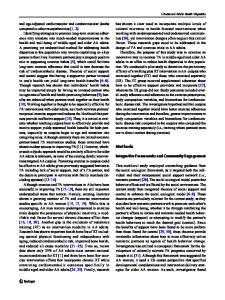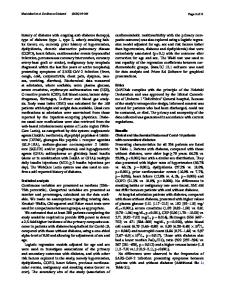Role of Resistance Exercise in Reducing Risk for Cardiometabolic Disease
- PDF / 147,277 Bytes
- 7 Pages / 595.276 x 790.866 pts Page_size
- 11 Downloads / 342 Views
Role of Resistance Exercise in Reducing Risk for Cardiometabolic Disease Angela S. Alberga & Ronald J. Sigal & Glen P. Kenny
Published online: 7 July 2010 # Springer Science+Business Media, LLC 2010
Abstract Resistance exercise training, also known as weight training or strength training, involves the use of muscular strength to work against a resistance or force. A large cohort study showed that resistance exercise was associated with reduced risk of cardiovascular disease. Resistance exercise increases lean body mass, improves muscular strength, and produces small reductions in body fat and blood pressure in overweight individuals with or without type 2 diabetes. Resistance training improves glycemic control in individuals with type 2 diabetes. Although the mechanisms underlying the small effects on lipid profile and inflammatory markers are unclear, resistance exercise is likely to be an important component of cardiovascular disease prevention. Keywords Resistance exercise training . Cardiovascular risk factors . Diabetes mellitus . Hemoglobin A1C . Lipids . Blood pressure . Inflammatory markers . Body composition . Obesity . Review A. S. Alberga : G. P. Kenny School of Human Kinetics, University of Ottawa, 125 University, Montpetit Hall, Ottawa, ON, Canada K1N 6N5
Introduction Cardiovascular disease (CVD) is the leading killer of American men and women [1]. Traditional modifiable risk factors include physical inactivity, hypercholesterolemia, hypertension, smoking, increased alcohol consumption, diabetes, and obesity. The non-modifiable risk factors include family history, male sex, and older age. Although several definitions exist for the metabolic syndrome, most organizations include the following criteria for the clustering of risk factors associated with increased risk of developing type 2 diabetes and CVD: abdominal obesity, low high-density lipoprotein (HDL) cholesterol, elevated triglycerides, glucose intolerance, and hypertension. The International Chair on Cardiometabolic Risk, the American Diabetes Association (ADA), and the American Heart Association (AHA) utilize “global cardiometabolic risk” to include the conglomeration of both traditional risk factors for CVD and the clustering of risk factors listed for metabolic syndrome as a better assessment of CVD risk [2].
A. S. Alberga e-mail: [email protected]
Exercise and Metabolic Risk
G. P. Kenny e-mail: [email protected]
Aerobic exercise training reduces cardiometabolic risk by reducing abdominal adiposity [3], improving lipid profile, reducing blood pressure, improving glycemic control [4], reducing systemic inflammation [5], and increasing cardiorespiratory (aerobic) fitness [6]. Aerobic exercise involves repeated and continuous movement of large muscle groups for a sustained amount of time [7]. Walking, cycling, jogging, and swimming are some examples of different forms of aerobic exercise training [7].
R. J. Sigal (*) Departments of Medicine, Cardiac Sciences, Community Health Sciences, Faculties of Medicine and Kinesiology, The University
Data Loading...











